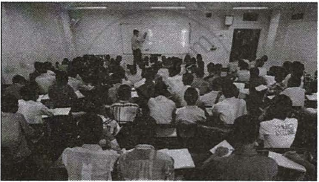Advertisements
Advertisements
Question
Show that the following system of equations has a unique solution:
`x/3 + y/2 = 3, x – 2y = 2.`
Also, find the solution of the given system of equations.
Solution
The given system of equations is:
`x/3 + y/2 = 3`
`⇒ (2x+3y)/6 = 3`
2x + 3y = 18
⇒2x + 3y – 18 = 0 ….(i)
and
x – 2y = 2
x – 2y – 2 = 0 …..(ii)
These equations are of the forms:
`a_1x+b_1y+c_1 = 0 and a_2x+b_2y+c_2 = 0`
where, `a_1 = 2, b_1= 3, c_1= -18 and a_2 = 1, b_2= -2, c_2= -2`
For a unique solution, we must have:
`(a_1)/(a^2) ≠ (b_1)/(b_2), i.e., 2/1 ≠ 3/(−2)`
Hence, the given system of equations has a unique solution.
Again, the given equations are:
2x + 3y – 18 = 0 …..(iii)
x – 2y – 2 = 0 …..(iv)
On multiplying (i) by 2 and (ii) by 3, we get:
4x + 6y – 36 = 0 …….(v)
3x - 6y – 6 = 0 ……(vi)
On adding (v) from (vi), we get:
7x = 42
⇒x = 6
On substituting x = 6 in (iii), we get:
2(6) + 3y = 18
⇒3y = (18 - 12) = 6
⇒y = 2
Hence, x = 6 and y = 2 is the required solution
APPEARS IN
RELATED QUESTIONS
Draw the graph of
(i) x – 7y = – 42
(ii) x – 3y = 6
(iii) x – y + 1 = 0
(iv) 3x + 2y = 12
Aftab tells his daughter, “Seven years ago, I was seven times as old as you were then. Also, three years from now, I shall be three times as old as you will be.” (Isn’t this interesting?) Represent this situation algebraically and graphically
Find the values of a and b for which the following system of equations has infinitely many solutions:
2x + 3y = 7
(a - 1)x + (a + 2)y = 3a
Solve for x and y:
x + y = 3, 4x – 3y = 26
Solve for x and y:
`3/x - 1/y + 9 = 0, 2/x + 3/y = 5`
For what value of k, the system of equations
kx + 2y = 5,
3x - 4y = 10
has (i) a unique solution, (ii) no solution?
The sum of two numbers is 137 and their differences are 43. Find the numbers.
A two-digit number is such that the product of its digits is 18. When 63 is subtracted from the number, the digits interchange their places. Find the number.
Read the following passage:
|
A coaching institute of Mathematics conducts classes in two batches I and II and fees for rich and poor children are different. In batch I, there are 20 poor and 5 rich children, whereas in batch II, there are 5 poor and 25 rich children. The total monthly collection of fees from batch I is ₹9,000 and from batch II is ₹26,000. Assume that each poor child pays ₹x per month and each rich child pays ₹y per month.
|
Based on the above information, answer the following questions:
- Represent the information given above in terms of x and y.
- Find the monthly fee paid by a poor child.
OR
Find the difference in the monthly fee paid by a poor child and a rich child. - If there are 10 poor and 20 rich children in batch II, what is the total monthly collection of fees from batch II?
Find the values of 'a' and 'b' for which the system of linear equations 3x + 4y = 12, (a + b)x + 2(a – b)y = 24 has infinite number of solutions.

